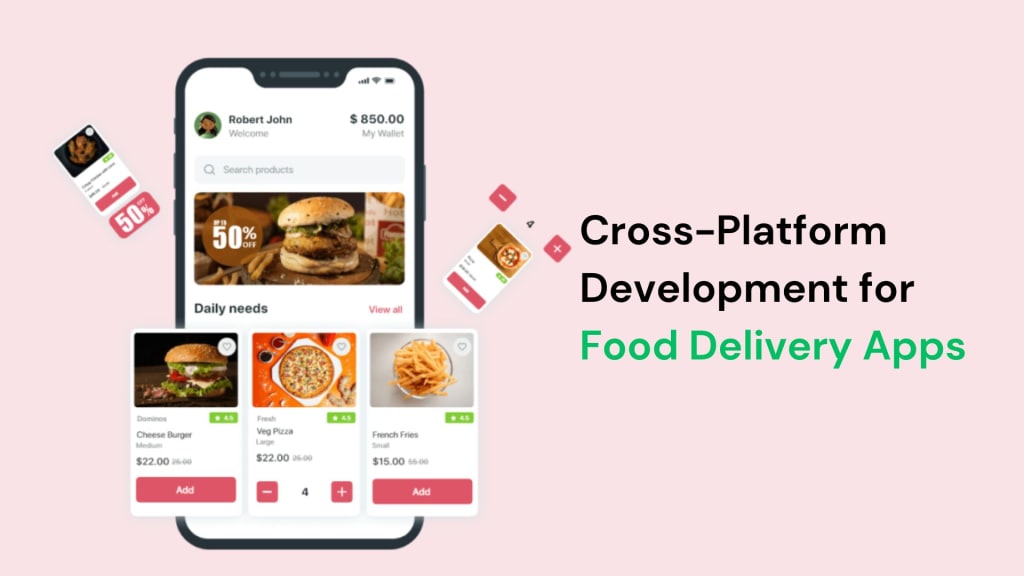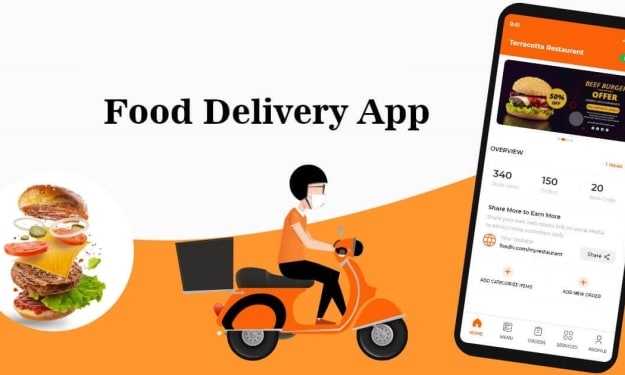Cross-Platform Development for Food Delivery Apps: Reaching Every Palate, Every Device
Cross-Platform Development for Food Delivery Apps

Introduction
In the modern, fast-paced world, the prevalence of on-demand services has revolutionized numerous industries, including the food delivery sector. This transformation has been greatly accelerated by the proliferation of smartphones and mobile applications, leading to a substantial increase in the popularity of food delivery platforms. Nevertheless, catering to a diverse user base employing various devices introduces a distinctive set of hurdles. This is precisely where the concept of cross-platform development emerges as a crucial solution. In this blog post, we will delve into the realm of cross-platform food delivery app development applications, exploring its advantages, obstacles, and recommended strategies for success.
Understanding Cross-Platform Development
Cross-platform development in the context of food app development involves creating applications that can seamlessly operate on multiple operating systems by utilizing a single unified codebase. Specifically, in the realm of food delivery applications, this approach entails crafting a singular app capable of delivering a seamless experience on both iOS and Android smartphones. This unification ensures that consumers enjoy a consistent and cohesive interaction, regardless of the platform they are using. By adopting this approach, the necessity of crafting and managing separate apps for various platforms is eliminated, resulting in significant savings of time, energy, and valuable resources.
Benefits of Cross-Platform Development for Food Delivery Apps
1. Cost Efficiency: Developing separate apps for iOS and Android can be expensive due to the need for two distinct development teams, different skill sets, and ongoing maintenance. Cross-platform development streamlines the process, significantly reducing development costs.
2. Faster Time to Market: With a shared codebase, developers can simultaneously build and deploy the app for multiple platforms, accelerating the time to market. This is crucial in the competitive food delivery industry, where speed can make a significant difference.
3. Consistent User Experience: Cross-platform development ensures a consistent look and feel across various devices, leading to a seamless user experience. This consistency enhances brand recognition and user trust.
4. Easier Maintenance: When updates or bug fixes are required, they can be implemented across all platforms simultaneously, reducing the maintenance effort and ensuring all users have access to the latest version.
5. Wider Audience Reach: By catering to both iOS and Android users, food delivery apps can tap into a larger user base, maximizing potential revenue and market share.
Challenges of Cross-Platform Development
1. Performance Optimization: While cross-platform frameworks have improved significantly, achieving optimal performance on both iOS and Android platforms can still be challenging. Careful optimization and testing are essential to ensure the app runs smoothly on all devices.
2. User Interface (UI) Consistency: Maintaining a consistent UI design across platforms can be tricky, as each operating system has its own design guidelines and user expectations. Striking a balance between platform-specific UI elements and a unified design is crucial.
3. Feature Parity: Ensuring that all features are available and function seamlessly on both platforms requires careful planning and development. Some features might need to be adjusted to align with each platform’s capabilities.
4. Third-Party Integration: Integrating third-party services, such as payment gateways or location services, can be more complex in cross-platform development due to potential compatibility issues.
5. Limited Native Functionality: Cross-platform frameworks may not fully leverage the native capabilities of each platform, potentially limiting the app’s functionality or performance in certain cases.
Best Practices for Cross-Platform Development
1. Choose the Right Framework: Selecting a suitable cross-platform framework is essential. Popular options include React Native, Flutter, and Xamarin. Consider factors such as community support, performance, and the ability to access native APIs.
2. Platform-Specific Adaptations: While aiming for a consistent UI, make necessary adaptations to adhere to each platform’s design guidelines and user expectations. This creates a more native and user-friendly experience.
3. Code Modularization: Divide the codebase into reusable modules that can be shared across platforms. This simplifies maintenance and updates, ensuring changes are applied uniformly.
4. Testing Across Devices: Rigorous testing on various devices and operating system versions is crucial to identify and address any compatibility or performance issues.
5. Optimize Performance: Implement platform-specific performance optimizations to ensure the app runs smoothly on both iOS and Android devices. Utilize profiling tools to identify bottlenecks and improve responsiveness.
6. Regular Updates: Keep the app updated with new features, bug fixes, and security patches across all platforms simultaneously to maintain a positive user experience.
Choosing the Right Cross-Platform Framework
The framework used for cross-platform development of food delivery apps is critical. Here are some common alternatives with their pros and cons:
1. React Native: React Native, which is supported by Facebook, is well-known for its near-native performance and huge community support. It enables developers to write JavaScript code and construct a sophisticated UI with React components. It also gives you access to native APIs, which makes it easier to integrate with device features.
2. Flutter: Developed by Google, Flutter uses a single codebase written in Dart to create expressive and natively compiled applications. It provides a highly customizable UI, enabling businesses to craft unique and engaging user interfaces. Flutter’s “hot reload” feature accelerates development and testing cycles.
3. Xamarin: Owned by Microsoft, Xamarin employs C# and .NET to build cross-platform apps. It offers a high degree of code reusability and access to native APIs. Xamarin.Forms, a subset of Xamarin, simplifies UI development by allowing developers to create a shared UI codebase.
4. NativeScript: Based on JavaScript or TypeScript, NativeScript enables developers to create native apps using web technologies. It provides access to native APIs and allows direct manipulation of native components, resulting in a truly native user experience.
The framework used is determined by criteria such as the skills of the development team, the desired app performance, the available resources, and the unique features required by the food delivery app.
Ensuring a Seamless User Experience
Creating a consistent and intuitive user experience is paramount in the food delivery industry. Here are strategies to ensure a seamless journey for users:
1. Intuitive Navigation: Design the app’s navigation flow to be user-friendly and predictable. Users should be able to effortlessly browse restaurants, menus, and place orders without confusion.
2. Real-Time Tracking: Implement real-time order tracking to provide users with transparency and reassurance about the status of their orders. Utilize GPS functionality to display the delivery person’s location accurately.
3. Efficient Search and Filtering: Incorporate robust search and filtering options to help users discover their desired cuisine, restaurant, or dish quickly. Consider adding filters for dietary preferences, pricing, and ratings.
4. Streamlined Checkout: Simplify the checkout process with clear instructions and minimal steps. Offer multiple payment options and ensure the payment process is secure and user-friendly.
Leveraging Location Services
Location plays a pivotal role in food delivery apps. Utilize location services to enhance the user experience:
1. Geo-Fencing: Implement geo-fencing to alert users when they are near their favorite restaurant marketing tool or when special offers are available nearby. This feature can entice users to explore and place orders.
2. Optimized Delivery Routes: Use location data to optimize delivery routes, ensuring that orders are delivered promptly and efficiently. This can lead to higher customer satisfaction and retention.
Security and Privacy
Security is paramount in any app, especially those handling sensitive user information. Consider the following:
1. Data Encryption: Implement end-to-end encryption for user data and payment information to protect against unauthorized access and breaches.
2. User Authentication: Use secure authentication mechanisms, such as OAuth or biometric authentication, to safeguard user accounts.
Scaling and Performance
As your food delivery app gains popularity, ensuring scalability and maintaining performance becomes crucial:
1. Cloud Integration: Utilize cloud services to scale resources as needed during peak times, such as weekends or holidays, to ensure uninterrupted service.
2. Caching and Offline Support: Implement caching mechanisms and offline support to allow users to browse menus and place orders even in low or no connectivity areas.
Marketing and User Engagement
Cross-platform development extends beyond the app itself to encompass user engagement strategies:
1. Push Notifications: Implement push notifications to keep users informed about promotions, new restaurants, or order updates. Personalize these notifications to increase their effectiveness.
2. Social Media Integration: Enable users to share their orders and experiences on social media platforms directly from the app. This can help in spreading the word and attracting new users.
3. Loyalty Programs: Introduce a loyalty program that rewards users for frequent orders. Cross-platform development allows you to seamlessly integrate loyalty features across different devices.
Compliance and Regulations
Food delivery apps must comply with various regulations and standards, including data protection laws, food safety guidelines, and payment security standards:
1. Data Privacy: Ensure that user data is handled in compliance with relevant data protection laws such as GDPR or CCPA. Clearly communicate your data practices to users.
2. Payment Security: Adhere to Payment Card Industry Data Security Standard (PCI DSS) requirements to secure payment transactions and protect user financial information.
Conclusion
Cross-platform development for food delivery applications brings up new avenues for catering to a wide user base while simplifying development processes. Your food delivery app can create an amazing experience that connects with users across several platforms and geographies by adapting to local markets, incorporating emerging technologies, improving user interaction techniques, maintaining compliance, and prioritizing continuous improvement. Cross-platform development is a strategic option that prepares your app for long-term success in a competitive and dynamic market as the food delivery business model evolves.
About the Creator
Transgenie
Our Delivery Management Software is the ultimate solution for businesses looking to optimize their delivery operations.
https://www.transgenie.io
Enjoyed the story? Support the Creator.
Subscribe for free to receive all their stories in your feed. You could also pledge your support or give them a one-off tip, letting them know you appreciate their work.






Comments
There are no comments for this story
Be the first to respond and start the conversation.